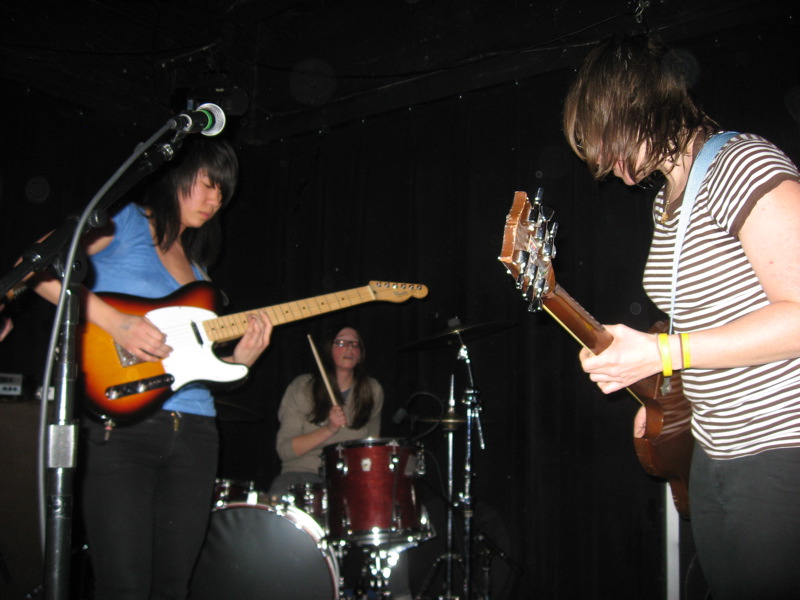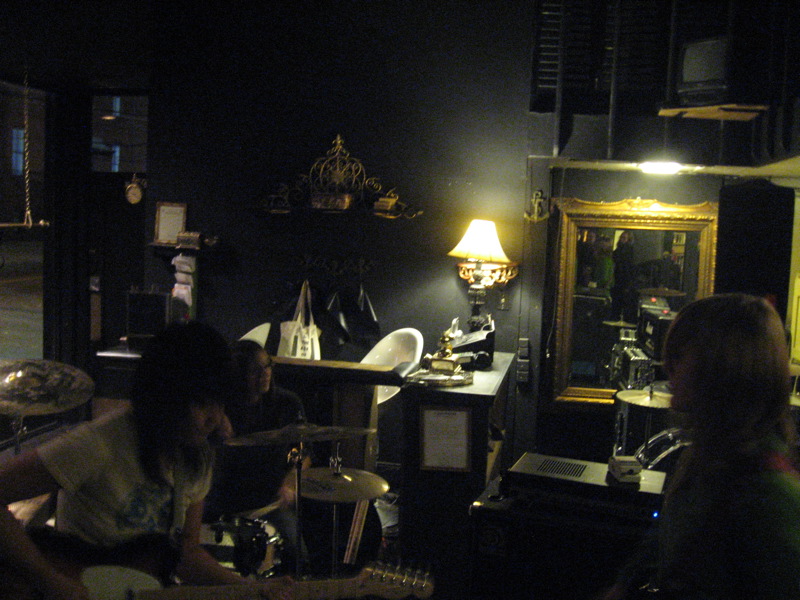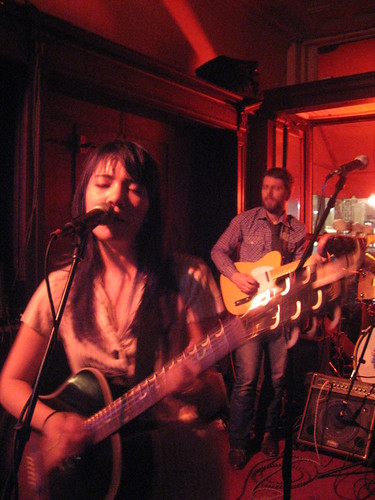Kazu Makino has reinterpreted and recorded a Yoko Ono song. Makino' s performance of “Listen, the Snow is Falling” (first released as a single by Ono in 1972) now in two parts opens and closes Recitement. The compilation album contains tracks that are half-spoken-word and half-music arranged and released by composer/musician Stephen Emmer from Amsterdam, Netherlands. Recitement can be previewed on the Recitement website.
The process of Recitement's production is unconventional: First text, then music. Singers, actors, and poets, such as Lou Reed and Allen Ginsburg, reinterpreted and performed “modern and classic” spoken word texts. Then Emmer composed music around the vocal performance. I read that Yoko Ono herself was pleased with Makino’s interpretation of Ono’s text.
Kazu Makino is known for her incredibly rich vocal palette in the no-wave-influenced (many people compare them to Sonic Youth) indie pop band Blonde Redhead based out of New York. One of my favorite tracks featuring Makino’s bleak visceral vocality is “I Still Get Rocks Off” from La Mia Vita Violenta” (1995). Her arty screams, moans, and cry-breaks sprinkle the track in unexpected ways and places. Makino rips her voice (or her throat!) with generosity, and with pain. Both In An Expression of the Inexpressible (1998) and “La Mia Vita Violenta” are blessed with an abundance of Makino’s noisy vocal gymnastics. Makino's style reminds me of Yoko Ono’s early vocalization, mostly during the Plastic Ono Band period (circa 1968-1972).
Makino’s tracks on Recitement sound promising from my preview of them. I will write about my reflection of them once I get a close listening of them. For now, I’m just excited to spread the word about this recording. Personally, I’m psyched about this Ono-Makino connection, which I always sensed in their music.
Here's a picture of Kazu Makino at Blonde Redhead's show last August (2007) at Rams Head in Baltimore taken by my photographer friend Chia Chi Chang:
2.29.2008
Kazu Makino of Blonde Redhead sings a Yoko Ono song
Posted by
wh
at
1:19 PM
5
comments
![]()
2.24.2008
Each Others Mothers rocked out with lovers at the Black Cat
I saw Each Others Mothers again at the Black Cat on 2/14/08 (Valentine's Day!!). They rocked the venue and blessed the lovers and valentines with their high-energy outpour of exuberant math indie punk. Plenty of notes, love, and fun! Their new tunes are sweet!!
@ the Black Cat, DC
Each Other's Mothers @ Rumors in Richmond on 11/17/07.
More pictures of Each Other's Mothers.
Posted by
wh
at
9:07 PM
0
comments
![]()
Labels: DC, field notes, shows
Magazine Interview about Asian Pacific American (APA) Music
I recently participated in an interview conducted by Inkstone, a UVa-based, student-run magazine devoted to Asian Pacific American (APA) literary arts and culture. The coming issue will feature a few UVa scholars (faculty and graduate student) who research APA arts. The issue will be released in late Spring this year. Below are contents most relevant to Yellow Buzz:
// What is Asian-Pacific-American music the way you understand it? //
Oh gees. This sounds like one of the questions on my comprehensive exams! APA music has yet to be canonized, although a number of academics and record labels have attempted to do so. For instance, Itchy Korean Recordings, based out of Houston, TX, released a compilation titled Wok and Roll featuring 14 multiethnic or Asian American punk and hardcore rock bands. Similarly, New York-based label Born in Chinese put out a compilation titled CompilAsian: A Collection of Asian American music, featuring 12 Asian American recording artists and groups of rock, pop, soul, and R&B. These recordings, in part, seek to shatter the silence or invisibility of Asian American representation in mainstream media. Also, MTVchi, an offshoot of the MTV network that broadcast program featuring Chinese American and other Asian American artists and VJ’s in order to cater to and create an Asian American audience, is another example of an institutional attempt to define APA music. This network, however, went off-air in 2005.
In many ways, I think, we’re still struggling with the baggage that otherizes Asian (or Orientalizes) culture inherited from the historical structures of the U.S. music industry. Specifically, the oppressive black-and-white racial binary still to this day informs our commonsensical understanding of commercial musical genres. There are white music genres such as country (historically known as “hillbilly” records) and rock. And there are music categories associated with African American performers and listeners, for example, hip hop and R&B, or the historical genre of “race records.” The racial binary that governs music genre division leaves a conundrum or a dilemma with which Asian American musicians grapple in their everyday struggle to express themselves authentically through the idiom of music.
Contrasting the general lack of APA musical representation is the active presence of Asian American musical production (consumption) at the grass-roots level. The current musical heterogeneity in Asian America resonates with the social diversity of the community. This makes it difficult to derive any generalities about the sound or content of this music. I personally resist the notion of APA music because it has not had a prominent existence in practice. What’s undeniable is the presence of APA musicians, professional, amateur, performing in all musical genres. Part of my academic (and musical) effort is to conjure (however) truthful images and narratives about the lives – and music – of these below-visibility APA musicians. For now, my working definition of APA music is the music made and listened to by individuals of Asian descent in the U.S. The broadness of this definition marks the yet exploratory state of this research.
// What does a reader/listener of APA music have to look forward to? //
Some of the most interesting music in Asian America emerges from the creative ways in which musicians have played with genre conventions. Anime punk (rock) is an example of this. Anime punk is the general subculture of anime in North America. Anime punk bands, mostly based out of New York, LA, and Tokyo, make frequent appearances at anime conventions in the United States.. Many of these bands perform in “character” in ways to resonate existing characters in familiar works of anime or more abstractly, to represent the general aesthetics of anime fashion and imagery. Peelander-Z, a self-identified “Japanese Action Comic Punk” band from Brooklyn, usually dress up in costumes and combine the raw sounds of punk and the interactive techniques from Japanese (as well as Korean and Taiwanese) game shows in performance. Their interactivity with the audience is astounding. I went to their show in Richmond last November and had a blast banging on pots and pans and watching them do “human bowling” offstage. By the way, they are coming to Charlottesville on March 5.
There are many other APA musicians who are doing innovative genre-bending. Carol Bui from DC blends in elements of Vietnamese pop singer Khanh Ly’s vocal style in her Sonic-Youth-and-Riot-Grrrl-inspired post-punk songs. And on her new album Everyone Wore White, Carol covers a traditional Vietnamese folk song a capella. Also, indie experimental rock band Kite Operations, led by Korean American Joseph Kim, just recently covered a Korean pop song in a free-jazz, late-Coltrane style. And, the Korean members of the feminist art rock band Taigaa! from Brooklyn cite “bbong jjak”, a pre-80s style of Korean pop music, as one of their main influences.
Musicians sometimes use conventionally Asian instruments in the context of American pop or rock music. For example, Jack Hsu of the Hsu-Nami fronts a New Jersey-based hard rock band playing amplified erhu, a traditional Chinese 2-string bowed instrument. Jack plays the erhu standing up with it clipped to his waist. He even shreds on his erhu! His main influences include Steve Vai and Slash of Guns N’ Roses.
There are many musicians who consciously derive musical inspirations from contemporary popular music genres in Asia such as JPOP, CPOP (MandoPOP, CantoPOP, and TPOP) and KPOP. Of course, there are many musicians of other genres that are transgressing ethnic/national boundaries. Yo Yo Ma’s Silk Road Project example is a well-known classical music example. Generally speaking, many of these musical links between US and Asia lead to or are products of actual transnational social connections between APA musicians and their Asian peers. This is especially made possible when APA musicians tour in Asia or when Asian groups tour in the U.S. This kind of transpacific social and musical connection – particularly the grassroots ones – is totally exciting to me.
// What will a reader/listener of APA music be disappointed with? //
I think the general lack of visibility of Asian Americans in music is disappointing. Hardly ever we see an Asian American person on mainstream TV network or on the cover of Rolling Stone, Spin or Vibe. There have been, of course, a few iconic Asian/Asian American figures in the U.S. cultural landscape: James Iha of Smashing Pumpkins, Joseph Hahn and Mike Shinoda in Linkin Park, Tony Kanal of No Doubt, Joey Santiago of the Pixies, Allen Pineda in Black Eyed Peas, Karen O of the Yeah Yeah Yeah’s, Lyrics Born, etc.
One thing that I find quite disappointing is there is much Asian American internal solidarity in music. While there are hip hop groups comprised of all Asian American members, such as the Mountain Brothers, most Asian American musicians perform and collaborate with white American musicians. So far I’ve only encountered a few bands composed of all Asian American members. I would like to see more of that.
// Describe the great and not-so-great moments of APA music history. //
One great moment in APA music history has to be Yoko Ono’s 2007 album release of Yes, I’m a Witch. Ono has unfortunately bore the onus for breaking up the Beatles for the last 35 years (which by the way was constructed mostly by media rumors and gossips). The vast and stimulating works of art and music has yet to be received much positive attention. This 2007 release consists of recordings of Ono’s music re-rendered and re-produced by leading indie rock, hip hop, and electronica figures including Cat Power, DJ Spooky, Le Tigre, Peaches, Flaming Lips, Antony (of Antony and The Johnsons), and many more. This album introduced Ono’s ahead-of-her-time songwriting skills and vocal style to a wide audience. And it has inspired listeners and critics to take Ono’s music and art seriously, possibly for the first time in history.
The appearance of William Hung on American Idol and subsequently in media marked a peculiar moment in APA music history. On the one hand, his performance yielded an array of responses. Some people uncritically embraced him for comic relief or commended him for being “clever” and achieving instant fame. Others vehemently censured his image and accused him of reinscribing the stereotype of the “Asian gook.” There were of course individuals who took his image literally thus perpetuating the Asian model minority myth. This was a very awkward moment for me. I felt like on the one hand, I had to come forward to assert my opinions about the William Hung “phenomenon”. On the other hand, I was intellectually curious about the complex construction and reception of his stardom. Politically, I would say, it was a not-so-great moment for Asian American representation in music.
Other than that, there are quite a few moments that scholars have discussed: the musical Flower Drum Song, with a mostly Asian cast, depicts the bicultural social life of Chinatown in San Francisco on Broadway and big screen first time in history; the Grain of Sand’s political folk songs that led and reflected the spirit of the Asian American identity politics movement in the early 1970s; and the Chinese American rapper Jin’s winning of “Freestyle Friday” on BET and his subsequent record deal with Ruff Ryders.
The final version of the interview will be posted on Yellow Buzz once the issue is released in late spring.
Posted by
wh
at
1:18 PM
3
comments
![]()
Labels: publication, reflection
2.12.2008
Thao with the Get Down Stay Down: Swinging & Rocking Charlottesville
 I’ve become a junkie to Thao Nguyen’s music. Her voice mystifies me. Her whimsical words swivel in fragments and her catchy tune freshen my earlier memories of sounds, warbles, and musical pleasures. Thao rocked the house with her DC-based band the Get Down Stay Down last Saturday night 2/9/08 at Miller’s. For a few hours that night, Thao and her band let in a little bit of air to freshen the Dave-Matthews-looming southern acoustic/jam rock cultural landscape of Charlottesville.
I’ve become a junkie to Thao Nguyen’s music. Her voice mystifies me. Her whimsical words swivel in fragments and her catchy tune freshen my earlier memories of sounds, warbles, and musical pleasures. Thao rocked the house with her DC-based band the Get Down Stay Down last Saturday night 2/9/08 at Miller’s. For a few hours that night, Thao and her band let in a little bit of air to freshen the Dave-Matthews-looming southern acoustic/jam rock cultural landscape of Charlottesville.
Thao led the band by playing an acoustic Gibson. Sometimes picking, other times strumming and striking the strings with a toothbrush, Thao played guitar while creating uneven sonic fabric upon which her vocals danced. She sang and played syncopated rhythmic patterns with precision, balanced by an appropriate level of spontaneity. Between songs, Thao and the band passed around a tiny bottle of Crown Oil. Slightly intoxicatedly, Thao's vocal cords relaxed and she graced us with soft yodeling: a break between vocal registers. What I heard was a unusual vocal timbre reminiscent of Bjork’s viscerality, David Gray’s vulnerable grittiness, and Norah Jones’ contempo-twang.
Thao and the Get Down Stay Down played songs from their new CD – We Braved Bee Stings and All – released by Kill Rock Stars a little more than a week prior to the show. A number of men and women in the audience knew the lyrics and sang along verbatim. Pleasures to the ear and the body (i.e., foot tapping, clapping, nodding, and finger dancing) permeated the bar and sneaked through the neon lights hung on the window to the brick pedestrian walkway of the Charlottesville Historic Downtown Mall.
Thao obscures her diction when she sings. But I’m not sure if diction and verbal contents are what matter the most in her music. Thao’s incredibly rich vocal palette is convincing. There’s no melodrama, literalism, or showiness. Her persistence of abstract playfulness is unforgetable. If I had to put my attraction to Thao's music in words, it’s her aesthetic leaning for fragmentation rather than holism, ambiguity over clarity, and an ironic yet ambivalent stance regarding the mundane. Whatever it is, she delivers it with plenty amicableness and artfulness. I imagine - many of us of the post-civil-rights generation resonate with Thao's self-conscious pleasures in our postmodern orientation in life. Rock on, Thao!
More images of the show.
Posted by
wh
at
4:57 PM
0
comments
![]()
Labels: field notes, shows, virginia




